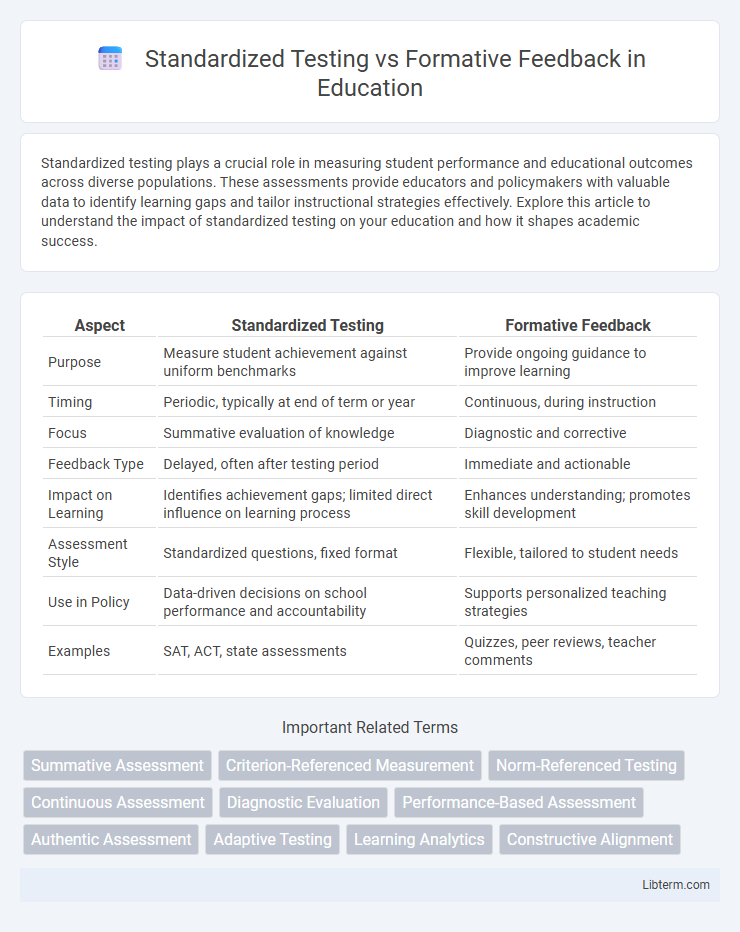Standardized testing plays a crucial role in measuring student performance and educational outcomes across diverse populations. These assessments provide educators and policymakers with valuable data to identify learning gaps and tailor instructional strategies effectively. Explore this article to understand the impact of standardized testing on your education and how it shapes academic success.
Table of Comparison
| Aspect | Standardized Testing | Formative Feedback |
|---|---|---|
| Purpose | Measure student achievement against uniform benchmarks | Provide ongoing guidance to improve learning |
| Timing | Periodic, typically at end of term or year | Continuous, during instruction |
| Focus | Summative evaluation of knowledge | Diagnostic and corrective |
| Feedback Type | Delayed, often after testing period | Immediate and actionable |
| Impact on Learning | Identifies achievement gaps; limited direct influence on learning process | Enhances understanding; promotes skill development |
| Assessment Style | Standardized questions, fixed format | Flexible, tailored to student needs |
| Use in Policy | Data-driven decisions on school performance and accountability | Supports personalized teaching strategies |
| Examples | SAT, ACT, state assessments | Quizzes, peer reviews, teacher comments |
Introduction to Standardized Testing and Formative Feedback
Standardized testing employs uniform assessments designed to measure student performance against established benchmarks across diverse populations, offering quantifiable data for educational evaluation. Formative feedback involves ongoing, personalized assessments aimed at guiding student learning by identifying strengths and areas for improvement during the instructional process. These contrasting approaches serve distinct educational purposes: standardized testing evaluates cumulative knowledge objectively, while formative feedback supports continuous learning and skill development.
Defining Standardized Testing: Purpose and Practices
Standardized testing serves as a uniform metric to assess student performance across different schools and districts, facilitating comparability and accountability in education systems. These tests typically emphasize multiple-choice or short-answer formats, designed to measure achievement in core subjects like math, reading, and science. The practices involve fixed administration conditions, scoring protocols, and benchmark standards to ensure consistency and validity of results.
Understanding Formative Feedback in Education
Formative feedback in education offers real-time insights into student learning, allowing educators to tailor instruction and address individual needs more effectively than standardized testing. It promotes continuous improvement by identifying specific strengths and weaknesses through interactive assessments, encouraging active student engagement and self-reflection. Emphasizing formative feedback helps create a dynamic learning environment that supports mastery and long-term academic growth beyond the limitations of one-time standardized exams.
Measuring Student Achievement: Comparative Overview
Standardized testing provides a uniform metric for measuring student achievement across diverse populations, enabling large-scale data analysis and benchmarking. Formative feedback offers personalized, real-time insights that promote continuous learning and address individual student needs more effectively. Combining both methods creates a comprehensive assessment strategy that balances objective measurement with tailored instructional support.
Pros and Cons of Standardized Testing
Standardized testing offers objective measurement of student performance across large populations, enabling comparative analysis and accountability in education systems. However, it often fails to capture individual learning nuances, creativity, and critical thinking skills, leading to teaching practices that prioritize test preparation over deep understanding. Critics argue that reliance on standardized tests can increase student stress and limit curriculum flexibility, while supporters highlight its role in identifying achievement gaps and informing policy decisions.
Advantages and Limitations of Formative Feedback
Formative feedback offers personalized learning insights that enable students to identify strengths and address weaknesses in real time, fostering deeper understanding and skill development compared to standardized testing. Its continuous nature supports adaptive teaching strategies tailored to individual progress, enhancing engagement and motivation. However, formative feedback can be time-consuming for educators to deliver consistently and may lack the broad comparability provided by standardized assessments.
Impact on Student Motivation and Learning Outcomes
Standardized testing often narrows student motivation, focusing on high-stakes performance rather than deep understanding and growth. Formative feedback promotes continuous learning by identifying strengths and areas for improvement, enhancing intrinsic motivation and engagement. Research indicates that formative feedback leads to higher academic achievement and greater long-term retention compared to standardized test-driven instruction.
Equity and Accessibility in Assessment Methods
Standardized testing often presents barriers for students with diverse learning needs, disproportionately affecting marginalized groups due to rigid formats and limited accommodations. In contrast, formative feedback promotes equity by providing personalized, ongoing support that adapts to individual learning styles and paces, improving accessibility. Implementing assessment methods centered on formative feedback fosters inclusive learning environments that better address varied student backgrounds and abilities.
Integrating Standardized Tests and Formative Feedback
Integrating standardized tests with formative feedback enhances student learning by combining objective measurement with real-time, personalized insights. This approach leverages data from standardized assessments to identify learning gaps while using formative feedback to tailor instruction, promoting continuous improvement. Educators adopting this integration create a balanced assessment system that supports both accountability and individualized student growth.
Future Trends in Educational Assessment
Future trends in educational assessment emphasize a shift from standardized testing towards formative feedback, prioritizing personalized learning and real-time data analytics. Advances in adaptive technologies enable continuous assessment through interactive platforms, providing detailed insights into student progress and areas needing improvement. This approach supports competency-based education models, fostering deeper understanding and skill mastery rather than mere test performance.
Standardized Testing Infographic

 libterm.com
libterm.com